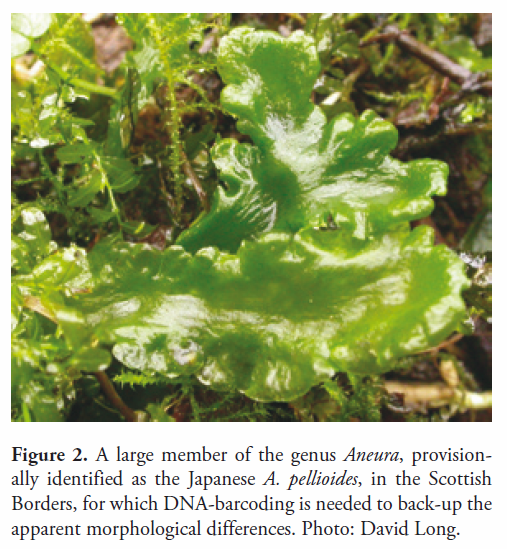In recent years, specimens of the simple thalloid liverwort Aneura with broad, thin Pellia-like thalli have started to be recognized as distinct, particularly in Europe. Three names have been mooted for these plants: Aneura maxima (Schiffn.) Steph., Aneura pellioides (Horik.) Inoue and Aneura sharpii Inoue & N.G.Mill. The most frequently used of these has been Aneura maxima, and the plant has been reported under this name from countries including Belgium, Norway, Sweden, Finland, Germany, Luxembourg, Poland, Czech Republic, Slovakia, Austria, France, Corsica, Portugal, Spain, Andorra, Romania and North-West Russia.

There’s been a general acceptance that bryophyte species can have very wide distributions – none of these species names are based on plants from Europe:
Aneura maxima was described (as Riccardia maxima Schiffn., 1898) from plants from Java, Indonesia. The species was transferred to Aneura (Stephani, 1899), and has previously been regarded as widespread in eastern and south-eastern Asia, eastern Australia and the southern Pacific.
Aneura pellioides was described (as Riccardia pellioides Horik., 1937) from plants from Japan, and has later been reported from Taiwan. The species was transferred to Aneura (Inoue, 1962), but subsequently (Inoue, 1976) considered to be the same species as Aneura maxima.
Aneura sharpii was described from plants from Tennessee (USA) (Inoue & Miller, 1985), and also reported from West Virginia, Pennsylvania, New York, Vermont, New Hampshire and South Carolina; it has subsequently been considered to be the same species as Aneura maxima (Schuster, 1992).
The name Aneura maxima has therefore been used to include Aneura pellioides, Aneura sharpii, and most large Aneura plants that have a broad (Pellia-like) thallus with thin margins and a thicker midrib.
We generated DNA barcode sequence data that includes plants from near the type localities of Aneura maxima (Java) and Aneura pellioides (Japan), and plants from the United States that we were sent in June 2008 by the late Dr Norton Miller, that had been identified by him as Aneura sharpii, as well as some of the Pellia-like Aneura plants that were collected in Europe.
There isn’t just one group of Pellia-like Aneura plants – they are in least five distinct groups (in bold type below), distributed among other Aneura specimens:
- Eastern North American Aneura sharpii
- European Aneura sp. 1 (= “Aneura maxima” in Bączkiewicz et al. 2017)
- Japanese Aneura pellioides and Aneura from southeast Asia
- Aneura pinguis (sensu Long et al. 2023)
- Aneura mirabilis (= Cryptothallus mirabilis)
- European Aneura sp. 2 (= “clade A” in Bączkiewicz et al. 2017)
- A genetically diverse complex of southeast Asian Aneura, including Aneura maxima.
From our study (Söderström et al. 2023), it seems that not only are the North American Aneura sharpii, the east Asian Aneura pellioides and the south-east Asian Aneura maxima all good, distinct species, but there are also two currently unnamed Pellia-like Aneura species in Europe.

- Bączkiewicz A., M. Szczecińska, J. Sawicki, A. Stebel, K. Buczkowska. 2017. DNA barcoding, ecology and geography of the cryptic species of Aneura pinguis and their relationships with Aneura maxima and Aneura mirabilis (Metzgeriales, Marchantiophyta). PLOS one 12 (e0188837): 1–21.
- Horikawa Y. 1937. Two new species of thalloid Hepaticae from Japan. Botanical Magazine, Tokyo 51: 427–430
- Inoue H. 1962. Hepaticae and Anthocerotae of the Chichibu-Okutama mountains, central Japan. The Journal of the Hattori Botanical Laboratory 25: 186–216.
- Inoue H. 1976. Illustrations of Japanese Hepaticae. 2. Tsukiji Shokan, Tokyo.
- Inoue H. & N.G. Miller. 1985. A new Aneura Dum. (Hepaticae, Aneuraceae) from eastern North America. Bulletin of the National Science Museum, Tokyo. Series B, Botany 11: 95–101.
- Long D.G., P.M. Hollingsworth, L.L. Forrest. 2007. Barcoding Britain’s liverworts and hornworts: a new project and request for material. Field Bryology 93: 10-13
- Long D.G., L.L. Forrest, K. Hassel, A. Séneca, L. Söderström. 2023. Typification of Jungermannia pinguis L. (Marchantiophyta, Aneuraceae). Edinburgh Journal of Botany 80, Article 1932: 1–11.
- Schiffner V. 1898. Expositio plantarum in itinere suo indico annis 1893/94 suscepto collectarum. Denkschriften der Kaiserlichen Akademie der Wissenschaften, Wien. Mathematisch-Naturwissenschaftliche Klasse 67: 153–20
- Schuster R.M. 1992. The Hepaticae and Anthocerotae of North America. V. Columbia University Press, New York.
- Söderström, L., L.L. Forrest, K. Hassel, D.G. Long, A. Séneca, Y. Inoue. 2023. Studies on Aneura (Aneuraceae): The Aneura maxima complex. Hattoria 14: 67–73.
- Stephani F. 1899. Species hepaticarum 1. Bulletin de lʼHerbier Boissier 7: 727–764.
Botanics Stories – Aneura
- Tidying up in Aneura – Botanics Stories (2023)
- Narrowing down Aneura pinguis – Botanics Stories (2023)
- The simple thalloid liverwort Aneura – a digitized resource at RBGE – Botanics Stories (2020)
- Barcoding Britain’s Liverworts – progress to date – Botanics Stories (2017)
- A mixed message on PCR additives in Aneura – Botanics Stories (2016)
- The Aneura Working Group meeting, Trondheim, 8th-12th February 2016 – Botanics Stories (2016)

